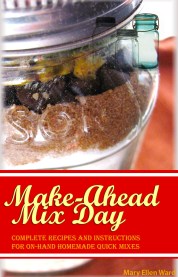Mason jar mixes are ideal for holiday gift-giving, especially when you have a long list of people to whom you care to show your appreciation. Gift jar mixes have the advantage of being affordable, appreciated, useful and attractive, all at the same time. They can fit the bill for a long line of gift recipients from coworkers to coaches, teachers, instructors, service providers, extended family members, and many more.
To be sure, having a variety of jar mix recipes to choose from is nice, but considering how busy and expensive the holidays can very easily get, it’s nice to have something a bit more versatile that can be worked up and packaged in short time, yet still deliver a number of excellent gift-giving options.
It’s All In How You Look At It
 Take, for example, the homemade all-purpose baking mix in Make-Ahead Mix Day. This recipe requires a minimal amount of ingredients (a couple cups of shortening, a standard five-pound bag of flour, a bit of salt, sugar, and baking powder), but it yields better than five quarts; and it only takes about five minutes to do it. Cheap and easy. Exactly what the budgeting gift-giver needs. The thing is, this mix can be used in numerous ways. So while you might not really want to give someone a dressed-up jar of “all purpose baking mix”, you’ll feel good about giving a nice homemade “Country Quick Mix” or “Sunday Morning Waffle Mix” with a nice label and instructions attached.
Take, for example, the homemade all-purpose baking mix in Make-Ahead Mix Day. This recipe requires a minimal amount of ingredients (a couple cups of shortening, a standard five-pound bag of flour, a bit of salt, sugar, and baking powder), but it yields better than five quarts; and it only takes about five minutes to do it. Cheap and easy. Exactly what the budgeting gift-giver needs. The thing is, this mix can be used in numerous ways. So while you might not really want to give someone a dressed-up jar of “all purpose baking mix”, you’ll feel good about giving a nice homemade “Country Quick Mix” or “Sunday Morning Waffle Mix” with a nice label and instructions attached.
If you take my meaning here, it’s all in the presentation and the suggestion. You’re still giving a great-tasting mix that you’ve put your own time, money, and effort into, but you’re giving it with style in a way you can afford.
You can search this site or the ‘net for different ideas and potential presentations, or go with one of your own favorite tried-and-true classics. Any recipe that uses Bisquick(R) or another biscuit or baking mix will work just fine with this recipe, so simply print the recipe to include with your festively-decorated jar mix (a nice parchment or holiday paper is a nice touch). To get the creative juices rolling, here is a list of ten great ways (in no particular order) to repackage this one simple mix and have a variety of gifting options:
- Morning Pancake Mix (what busy Mom or Dad wouldn’t appreciate that?)..top it off with a half cup of chocolate chips or dehydrated fruit and now you have flavored pancakes, to boot.
- The aforementioned “Sunday Morning Waffle Mix” (to which the same doctoring methods above apply)
- Home Style Country Biscuit Mix
- Quick & Tasty Cinnamon Roll Kit (gifted in a basket with a small jar of powdered sugar and nicely-tied baggie or small jar of cinnamon sugar)
- Muffin Mix
- Quick Bread Mix (with or without additions)
- Scone Mix
- Cornbread Mix (just add in the 6 TBSP of corn meal – especially nice with a bean mix for soup or chile)
- Cupcake Mix
- Tea-Time Coffee Cake Mix (throw in a sealed baggie with topping ingredients on top of the mix in the jar)
So you see with a little imagination giving a quality homemade gift does not have to be overly costly or time-consuming. You can feel good about giving gifts to everyone on your list without stressing yourself or breaking the budget.
You can find both an easy all-purpose baking mix suitable for these and many other recipes and a variety of other equally good jar mix recipes for Christmas gifts (or just healthier, more affordable pantry-stocking!) in Make-Ahead Mix Day: Complete Recipes and Instructions for On-Hand Homemade Quick Mixes. It’s available for Kindle and compatible eReader apps as well as in a downloadable PDF.
Be sure to Subscribe to The Homemade Homestead keep up with all the recipes and posts from The Homemade Homestead. You’ll get only updates from this site, and your information will not be sold!
















